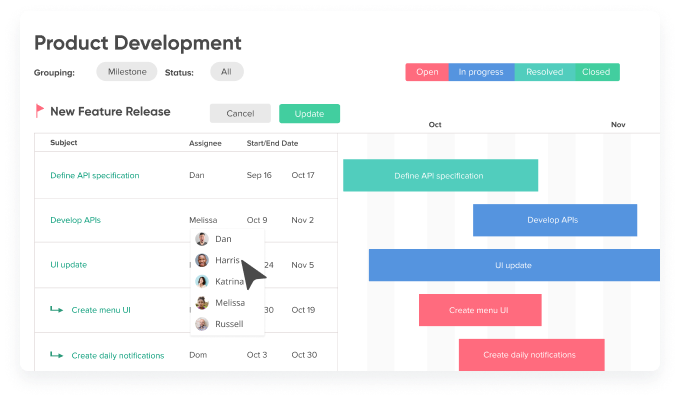How good organizational effectiveness levels up your productivity
Georgina Guthrie
August 24, 2022
Organizational effectiveness may sound a bit like a business buzzword, but it’s a simple and genuinely useful concept. Not to mention, it’s the driving force behind the world’s biggest organizations.
Essentially, organizational effectiveness is a measure of how well a business functions. We can evaluate effectiveness in terms of productivity, profitability, growth, and employee satisfaction, among other things.
To help you understand this concept, we’re going to unpack it in more detail and share some tips for putting it into action. Let’s dive in!
What is organizational effectiveness?
Organizational effectiveness (OE) is a term used in business and management sciences to evaluate how successful an organization is at achieving its goals without waste. A number of factors can contribute to organizational effectiveness, including the company’s size, structure, culture, and leadership.
OE is usually measured in terms of four key things:
- Productivity: productivity is a measure of how much output an organization generates per unit of input. It’s typically measured in terms of revenue, sales, or the number of products or services produced.
- Profitability: profitability is a measure of how much money an organization makes relative to its costs. It’s usually measured as net income (income after expenses are deducted) or return on investment (the amount of profit generated relative to the amount invested).
- Growth: growth is how much an organization expands over time. It’s measured in terms of the number of employees, the number of customers or clients, or total revenue.
- Employee satisfaction: employee satisfaction is a measure of how happy employees are with their work. It’s assessed through surveys and interviews or by tracking indicators such as turnover or absenteeism rates.
When these things are all good, it’s a sign that you’ve achieved organizational effectiveness. If one or more of these metrics isn’t looking good, it means there’s work to do (more on this later).
What does an Organizational Effectiveness Officer (OEO) do?
In short, the OEO works to help organizations improve their performance. Typical responsibilities include identifying areas where the company can improve, developing plans to address those areas, and implementing change initiatives.
The OEO may also be in charge of measuring the organization’s progress and communicating results to stakeholders. They have a strong understanding of organizational theory and how to apply it in practice.
Why is organizational effectiveness important?
Organizational effectiveness directly impacts your organization’s ability to achieve its goals and objectives. While it might not determine success on its own, having good organizational effectiveness means waste and inefficiencies won’t be the things that hold you back. Here are three reasons why it’s important.
1. It helps you keep pace with the competition
Ineffective processes are the last thing you want when operating in a busy marketplace, and all your competitors are running like well-oiled machines. If your organization’s basic operations function well, you’ll have more time to push ahead with innovation and customer service.
2. It helps you retain talent
Organizational effectiveness influences your ability to attract and retain top talent. Few things are more frustrating than having bad processes getting in the way of you doing good work. Therefore, if you want to hold onto your best employees, your organization should run smoothly and offer growth opportunities.
3. It’s good for your bottom line
When you aren’t wasting time putting out metaphorical fires, you have more resources to channel into revenue-generating activities. You’ll also waste less time fixing issues caused by inefficiencies. For these reasons, effective organizations tend to be more profitable than those that are not. It’s that simple!
2 real-world examples of companies that have achieved organizational effectiveness
Let’s look at a few examples of organizational effectiveness at work. These well-known companies didn’t become the giants they are today without a ruthless approach to inefficiencies.
Apple
Apple is structured for innovation, and its culture plays a big part in that. Before Jobs arrived, the company had a very conventional structure with departments split into business units. One of the first things he did was break down those barriers and create what he called a ‘matrix organization.’
The matrix approach allowed different groups to work together more closely and share resources, which led to greater efficiency and faster decision-making. As a result, Apple brought ground-breaking products to market quickly and efficiently. And it has remained at the forefront of the tech industry ever since.
Toyota
Continuous improvement has been a core value of Toyota since its inception, and it’s credited as being the driving force behind the company’s success. Over the years, the business has implemented many systems and processes to foster a culture of improvement. The Toyota Production System, which emphasizes waste reduction and continuous flow, is one of the most famous examples.
Organizational effectiveness: best practice
Several factors contribute to organizational effectiveness, including:
1. A clear strategy
The first step to achieving success is to have a clear understanding of what the organization wants to achieve, aka its strategy. You should have a well-defined mission statement and a roadmap to success.
Create a strategy by developing clear goals and objectives, strong internal branding, and a shared vision among employees. Above all, cultivate strong leaders committed to effectiveness across all facets of the business — from hiring and team-building to managing communications and running daily standups.
2. A positive work culture
A positive work environment is essential for employee satisfaction and engagement. It also dictates how effectively employees work. Countless studies have drawn direct links between productivity and employee motivation and engagement. So, make sure your team culture is set up for success.
Have a clear sense of purpose (your mission statement will help), training and growth opportunities, great organizational communication, and team-building activities to bring everyone together.
3. An effective way to measure progress
How will you know how well you’re doing if you don’t measure progress? Organizations must regularly assess their performance to ensure they’re on track to achieve their goals. This includes setting KPIs and conducting regular performance reviews.
- What goals are you and the team working towards? Is everyone in agreement with what these are?
- How often will you measure key milestones, and what processes do you have in place for checking and reporting this?
Project management software can help organizations track progress and measure their effectiveness. Whatever tools you choose should allow you to set goals and objectives, track milestones, and measure results.

4. Streamlined communication processes
Organizations need clear and effective communication channels, both internally and externally. They also need systems and processes to make decisions, such as task management and resource allocation. To promote better collaboration, formalize your guidelines for effective communication, including guidance for remote and hybrid workers.
5. A commitment to continuous improvement
If you aren’t moving forward, you’re staying still. And in the business world, this is as good as going backward. Organizations must continually improve their performance by setting new goals, implementing feedback mechanisms, and investing in employee development.
6. Transparency
Organizations must communicate their progress to stakeholders to keep them informed and engaged. Make an ongoing effort to share successes and lessons learned and communicate plans for future improvement.
Project management software can also help you out here. Instead of waiting until weekly or monthly check-in meetings, simply give stakeholders access to your software, and they’ll receive all the notifications they need in real-time. Not only does this help them feel connected to your progress, but the project manager can reduce the time spent sending updates and scheduling meetings.
Final thoughts
There’s no one-size-fits-all model for organizational effectiveness. Each company will have its own unique goals and objectives. That said, there are a few essential components for achieving organizational effectiveness. With a clear vision and mission statement, good communication and decision-making processes, a commitment to continuous improvement, and the collaboration tools to help you make it all happen, you’ll be well on the way to success.


